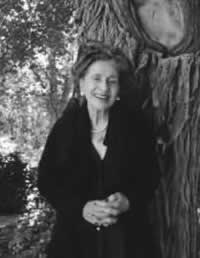Santa Fe Living Treasures – Elder Stories
|
Concha Ortiz y
|
Concha Ortiz y Pino de Kleven The life of Concha Ortiz y Pino de Kleven was larger than life. Much larger. Her first ancestor to come to New Mexico from Spain served as an officer under Gen. Don Diego de Vargas, who reconquered the territory in 1692 after the Pueblo Revolt of 1680. Her great-great-grandfather was the only New Mexican ever to sit in Spain’s ruling body, the Cortes, where he served in 1810. Her father was a rich patron in the village of Galisteo, where Concha was born in 1910, and on a 100,000-acre ranch. When Concha graduated from Loretto Academy in Santa Fe, the nuns told her father she would never amount to anything because she was rebellious and headstrong. Instead she got him to start a Hispanic crafts co-op, which she ran to help impoverished neighbors. When Franklin Roosevelt first ran for U.S. president in 1932, she toured the whole state leading rallies for him. In 1936 she was elected to the New Mexico House of Representatives, then served two more terms, the final one as the nation’s first female minority whip in a legislative body. In the Legislature she championed women’s rights, bilingual education, equal funding for urban and rural schools, and a bill to establish a School for Inter-American Affairs at the University of New Mexico. After leaving the Legislature, she attended that school, and earned a degree in its first graduating class. She fell in love just once, and her husband, Victor Kleven, was a Canadian-born college professor and lawyer, a former Rhodes Scholar, a World War I veteran and one of the founders of the short-lived League of Nations, the forerunner to the United Nations. He taught at UNM, and Concha became president of the Faculty Wives Club. She was officially named “Albuquerque’s Best-Dressed Woman,” and unofficially was noted for the city’s “best legs.” Movie star Clark Gable asked her to take a screen test for a film. When her father became too ill to run the ranch, Concha became its “boss lady,” moving into a ramshackle two-room ranch house infested with bats and bedbugs. She drilled a new deep well, got the state to build new roads to the ranch, and brought telephone and electric lines for the first time. She also brought the first television set, and in the evening after work, the ranch hands would crowd into her house to watch it. She paid down the ranch’s debt, returned it to prosperity, and built a new house for herself and her husband, who visited frequently from the university. But on the day they were to christen their home, Victor died of a cerebral hemorrhage, leaving her a widow at 46. Concha sold the ranch and returned to Albuquerque, to plunge into a life of endless service to social causes and the arts. She helped crippled children, the blind, prison inmates, emotionally disturbed adults, victims of Alzheimer’s disease and sickle cell anemia. She served on the boards of museums, theaters and musical groups, fought for historic preservation, the Hispanic culture, and U.S.-China relations. Five American presidents--from John Kennedy to Jimmy Carter--appointed her to national commissions. The city of Cádiz, Spain, declared her an honorary citizen. She sat on the national board of the Conference of Christians and Jews. New Mexico named a state-government building for her. She was honored as a Living Treasure in both Albuquerque and Santa Fe. She posed for numerous portraits and sculptures. In her own assessment, however, her greatest accomplishment was the deep friendship she formed with countless people. Through the years, Concha was saluted both as a “matriarch” and a “grande dame.” Two decades before her death in 2006 at the age of 96, the American Association of University Women declared her one of the “10 Outstanding Women in New Mexico History Since 1850.” Impressive as it was, the honor almost seemed an understatement.
Story by Richard McCord Photo © 2000 Steve Northup
|

